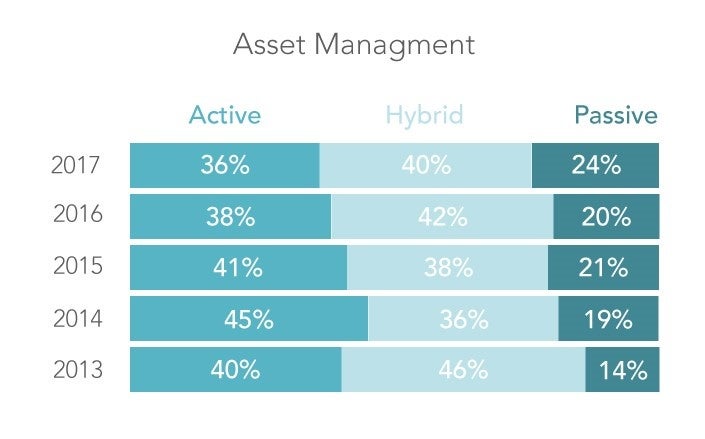The findings in this blog post come from our annual survey of over 1,500 registered investment adviser (“RIA”) firms that was conducted in the first quarter of 2018. This proprietary RIA in a Box study is paired with publicly accessible data provided by the Securities and Exchange Commission (“SEC”). The goal of our annual study is to understand different options that comprise each firm characteristic, and to determine whether specific characteristics affect the growth, size, or operational efficiency of an RIA firm. In this blog post, we focus on the popularity and the differences seen with firms that utilize different portfolio management styles. Portfolio management style is defined as the primary investment management style that firm uses to manage its clients assets: active, passive, or hybrid (a mix of both active and passive).
Portfolio Management Styles
RIA firms determine whether to manage client investment portfolios with an active, passive, or hybrid management style. An active approach generally implies buying and selling securities with the intent of outperforming an investment benchmark index. Firms that employ an active portfolio management style may utilize mutual funds, exchange traded funds, individual securities, or an array of other types of securities products, but regardless of the investment product being utilized, the firm is focused on trying to outperform an index. A passive approach generally implies utilizing index funds or similar investment vehicles such as exchange-traded funds with the intent of mirroring an investment benchmark index. Hybrid firms, in regards to portfolio management style, are not absolute in their investment philosophy and may offer a mixture of passive and active portfolio management solutions to their clients (e.g. a core and satellite investment strategy). For example, some hybrid firms may utilize a passive approach for managing equities and then perhaps an active strategy for managing fixed income securities.
This Year’s RIA Survey Results
This year’s survey results echo recent survey results. Larger firms, as measured by total assets under management (“AUM”), are more likely to use an exclusively passive portfolio management style. Firms that manage portfolios passively are more likely to grow AUM at a faster pace relative to their peers. In addition, firms that utilize passive portfolio management generally charge a lower advisory and total fee to their clients relative to other firms in the industry.

Over the past 5 years, we have seen RIA firms trend towards using a passive or hybrid portfolio management approach. 45% of RIA firms utilized an exclusively active portfolio management style in 2014 compared to 36% of all RIAs presently. On the other hand, firms deploying an exclusively passive portfolio management style have steadily increased from 14% of firms in 2013 to 24% presently. However, it’s important to note that a hybrid portfolio management style is still the most common investment management strategy used by RIA firms:

In the past, we speculated that the new DOL rule could increase the popularity of more passive approaches in portfolio management. Although we did see a sizable decrease in firms that primarily offer active management over the past few years, it’s difficult to attribute that continued shift to a single cause. However, we do expect the trend towards passive and hybrid portfolio management to continue due to the increased transparency and focus on underlying product and total client advisory fees less due to new regulations, but more due shifting investor preferences.
